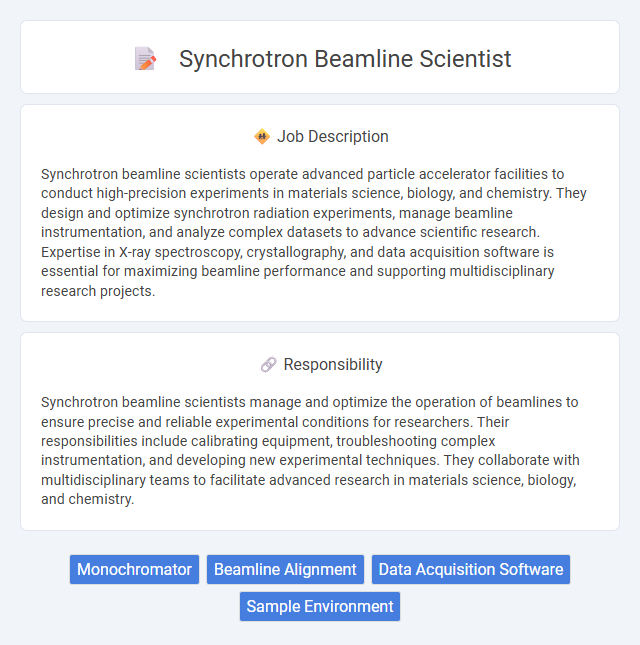
Synchrotron beamline scientists operate advanced particle accelerator facilities to conduct high-precision experiments in materials science, biology, and chemistry. They design and optimize synchrotron radiation experiments, manage beamline instrumentation, and analyze complex datasets to advance scientific research. Expertise in X-ray spectroscopy, crystallography, and data acquisition software is essential for maximizing beamline performance and supporting multidisciplinary research projects.
People with strong backgrounds in physics, engineering, or materials science are likely to thrive as synchrotron beamline scientists, especially if they exhibit high precision, problem-solving skills, and adaptability to complex instrumentation. Individuals who enjoy collaborative research environments and continuous learning may find this role suitable, given the interdisciplinary nature and rapid technological advancements in synchrotron facilities. However, those who prefer routine tasks or limited interaction with cutting-edge equipment might find the position less fitting for their preferences.
Qualification
A Synchrotron Beamline Scientist typically holds a Ph.D. in physics, chemistry, materials science, or a related field with extensive experience in synchrotron radiation techniques and instrumentation. Proficiency in X-ray scattering, spectroscopy, or diffraction methods, combined with strong analytical and computational skills, is essential for designing experiments and interpreting complex data. Expertise in beamline operation, safety protocols, and collaborative research enables effective support for scientific user communities and development of advanced experimental setups.
Responsibility
Synchrotron beamline scientists manage and optimize the operation of beamlines to ensure precise and reliable experimental conditions for researchers. Their responsibilities include calibrating equipment, troubleshooting complex instrumentation, and developing new experimental techniques. They collaborate with multidisciplinary teams to facilitate advanced research in materials science, biology, and chemistry.
Benefit
A Synchrotron beamline scientist role probably offers unique access to cutting-edge research facilities, enabling advanced experimentation in materials science, biology, and chemistry. They likely benefit from collaborative opportunities with leading scientists, fostering professional growth and innovation. Competitive compensation and the chance to contribute to groundbreaking discoveries may further enhance job satisfaction.
Challenge
A Synchrotron beamline scientist likely faces the challenge of optimizing complex experimental setups to achieve precise data acquisition in highly variable conditions. They probably need to troubleshoot and adapt instrumentation rapidly to address unforeseen issues during experiments. Managing interdisciplinary collaboration while balancing technical demands and scientific goals may also present ongoing difficulties.
Career Advancement
Synchrotron beamline scientists leverage expertise in physics, materials science, and advanced instrumentation to optimize beamline performance and conduct cutting-edge research, driving innovation in fields such as structural biology, nanotechnology, and environmental science. Career advancement opportunities include leading large-scale research projects, managing beamline facilities, and contributing to scientific publications and grant writing, which enhance professional reputation and leadership skills. Developing multidisciplinary collaborations and staying current with synchrotron technology advancements open pathways to senior scientist roles, academic appointments, or technology development positions in industry.
Key Terms
Monochromator
A Synchrotron beamline scientist specializing in monochromators plays a critical role in optimizing the performance of monochromatic X-ray beams for advanced research applications. Expertise in designing, calibrating, and maintaining monochromators ensures precise wavelength selection and energy resolution, essential for experiments in materials science, biology, and chemistry. Proficiency in synchrotron instrumentation, beamline optics, and data analysis directly supports cutting-edge scientific discoveries and enhances beamline efficiency.
Beamline Alignment
A Synchrotron beamline scientist specializes in precise beamline alignment to ensure optimal X-ray or particle beam delivery for experiments. This role involves utilizing laser systems, motors, and diagnostic detectors to calibrate beam position, angle, and focus within stringent tolerances. Accurate beamline alignment is critical for achieving high-resolution data and maintaining experimental reproducibility in synchrotron radiation facilities.
Data Acquisition Software
A Synchrotron Beamline Scientist specializing in Data Acquisition Software develops and optimizes complex software systems to capture, process, and analyze high-throughput experimental data generated by synchrotron radiation facilities. Proficiency in programming languages such as Python, C++, and LabVIEW is essential for designing efficient data pipelines, ensuring real-time data integrity, and integrating with hardware control systems. Expertise in handling large-scale datasets, synchronization protocols, and user interface design enhances experimental throughput and accuracy in cutting-edge materials science and biological research.
Sample Environment
A Synchrotron Beamline Scientist specializing in Sample Environment manages the optimal conditions for experiments, including temperature, pressure, and atmosphere control, to ensure precise data acquisition. Expertise in customized sample holders, cryostats, furnaces, and environmental chambers is essential for accommodating diverse scientific investigations. Collaboration with beamline engineers and researchers facilitates the integration of advanced sample environment technologies to maximize experimental outcomes.
 kuljobs.com
kuljobs.com